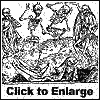
|
A Time of Turmoil By Brian Orr Have a question? Click Here to go to Brian's own Discussion Board!
These were intended as secure bases from which the sheriffs helped to pacify the region; and as defences against the lawless bands. They also became the centres from which trade developed in surplus agricultural produce being influenced by the success of the Cistercian monks who had developed sheep farming and manufacture of associated goods.
It is sometimes forgotten that feudal military service took the men from the land and it is more than coincidence that famine was common and often followed by pestilence and plague. Thus the turmoil, famine, plague, and constant demands for military service would have been cause enough for the migration of people who had been held in thrall by the local lords for so long.
As Prince of Cumbria David (King David 1124-1153) had caused an inquisition to be made of the lands and buildings that had belonged to the ancient church. Acting on that information David created the bishopric of Glasgow in 1121. This new diocese stretched from the river Clyde to the Solway and from the Lothians to the river Urr in Kirkcudbright shire.The consequence was a rapid growth of feudalism with land becoming the basis of power.
In his reign the Culdee churches of the Celts at St. Andrews and Lochleven disappeared and new
monasteries arose and existing ones were strengthend.
You can talk to Brian Orr on his own Discussion Board or you can click here to read more about his extensive research on the Orr family name. |
Thursday, December 26th, 2019
Attention visitors: Tartans.com is back. Please note that this is a snapshot of the site as it existed nearly 20 years ago and you may encounter broken links; we are still combing through the site and correcting those as we find them. Please also note that some sections are currently not functional, primarily the discussion forums/clan chat boards.
|
** HOME - First Time Visitors - Glossary - - Contact Us ** Awards | Bibliography | Clan Calendar | Clan Chat | Clan Finder | History | Famous Scots | Genealogy | Great Hall of the Clans | Links | News and Features | Scots on the Net | Search | Site Map The Gathering of the Clans
Copyright 1995- Tartans.com - All Rights Reserved. |


